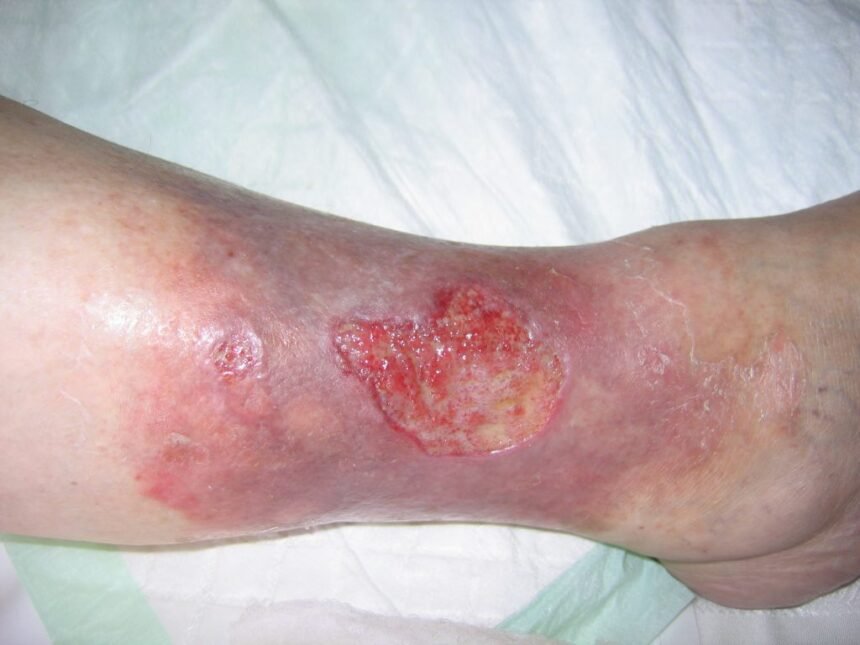Venous leg ulcers are a common yet serious condition affecting millions of people worldwide. These chronic, slow-healing wounds typically develop on the lower legs due to poor circulation and venous insufficiency. Without proper care, venous ulcers can lead to infections, severe pain, and long-term complications. In this guide, we will explore the causes, symptoms, and best treatment options for venous leg ulcers, helping you understand how to manage and prevent them effectively.
What Are Venous Leg Ulcers?
A venous leg ulcer is an open sore that develops when veins in the legs fail to return blood efficiently to the heart. This condition is often a result of chronic venous insufficiency (CVI), where damaged vein valves allow blood to pool in the lower limbs, leading to increased pressure, swelling, and eventually skin breakdown.
Venous leg ulcers typically appear on the inner side of the lower leg, near the ankle, and can take weeks or even months to heal if not properly managed.
Causes of Venous Leg Ulcers
Venous ulcers are primarily caused by poor circulation and venous insufficiency, but several factors contribute to their development:
1. Chronic Venous Insufficiency (CVI)
- The most common cause of venous ulcers.
- Weak or damaged vein valves cause blood to pool in the legs, increasing pressure and breaking down the skin.
2. Deep Vein Thrombosis (DVT)
- Blood clots in deep leg veins can damage vein valves, leading to poor circulation and increased ulcer risk.
3. Varicose Veins
- Swollen, twisted veins make it difficult for blood to flow properly, contributing to skin breakdown.
4. Leg Injuries or Surgery
- Previous injuries, fractures, or surgeries can lead to venous insufficiency, increasing the risk of ulcers.
5. Obesity and Lack of Physical Activity
- Excess weight and prolonged sitting or standing put pressure on leg veins, worsening circulation.
6. Aging
- Older adults are at higher risk due to natural vein deterioration and slower healing processes.
Symptoms of Venous Leg Ulcers
Recognizing the early signs of venous ulcers can help prevent complications. Common symptoms include:
1. Skin Changes
- Dark, reddish-brown discoloration around the lower leg and ankle.
- Skin thickening or hardening (lipodermatosclerosis).
2. Swelling and Heaviness in the Legs
- Persistent leg swelling that worsens throughout the day.
- Feeling of heaviness or aching in the lower legs.
3. Open Wound That Doesn’t Heal
- A shallow, painful ulcer with irregular edges.
- Yellowish, green, or foul-smelling discharge (if infected).
4. Itching, Burning, or Pain
- Persistent itching around the ulcer site.
- Pain that increases when standing for long periods.
5. Signs of Infection
- Increased redness, warmth, or swelling around the ulcer.
- Fever or pus formation in severe cases.
Treatment Options for Venous Leg Ulcers
Proper treatment is essential for healing venous leg ulcers and preventing recurrence. Here are the most effective treatment options:
1. Compression Therapy (First-Line Treatment)
- Compression bandages or stockings improve blood circulation and reduce swelling.
- Helps veins push blood back toward the heart, speeding up healing.
2. Wound Care and Dressing
- Regular cleaning with a saline solution to prevent infection.
- Use of moist wound dressings (hydrocolloids, foam, or alginate) to promote healing.
Not sure which dressing to use? Here’s a complete guide: Best Wound Dressings for Venous Leg Ulcers
3. Medication
- Antibiotics (only if infection is present).
- Pain relievers for discomfort.
- Medications to improve circulation, such as pentoxifylline.
4. Lifestyle Changes
- Elevate legs when sitting or sleeping to reduce swelling.
- Exercise regularly to improve circulation.
- Maintain a healthy weight and follow a low-sodium diet.
5. Minimally Invasive Procedures
- Sclerotherapy (injecting a solution to close damaged veins).
- Endovenous laser therapy (EVLT) or radiofrequency ablation (RFA) to remove diseased veins.
6. Surgical Options (For Severe Cases)
- Vein bypass surgery to redirect blood flow.
- Skin grafting to cover large, non-healing ulcers.
manage your ulcer at home? Check out our guide: Daily Care Tips for Venous Leg Ulcers
Preventing Venous Leg Ulcers
Prevention is key to avoiding venous leg ulcers, especially if you have a history of circulation problems. Here’s how to reduce your risk:
- Wear compression stockings daily to improve blood flow.
- Stay active – walk, stretch, and avoid long periods of standing or sitting.
- Maintain a healthy weight to reduce pressure on veins.
- Elevate legs for 15-20 minutes daily to prevent swelling.
- Keep skin moisturized to prevent dryness and cracks.
- Treat varicose veins or venous insufficiency early to avoid complications.
When to See a Doctor
Seek medical attention if:
- The ulcer doesn’t show signs of healing after 2-4 weeks.
- There are signs of infection (increased redness, swelling, pus, or fever).
- Pain becomes severe or unmanageable.
- The ulcer reoccurs frequently.
Conclusion
Venous leg ulcers are a serious but manageable condition when treated promptly. By understanding the causes, symptoms, and effective treatments, you can take control of your health and prevent complications. Proper wound care, lifestyle changes, and medical treatments can significantly improve healing and quality of life.


Leave a Reply